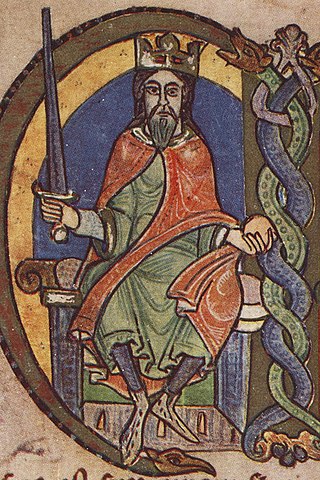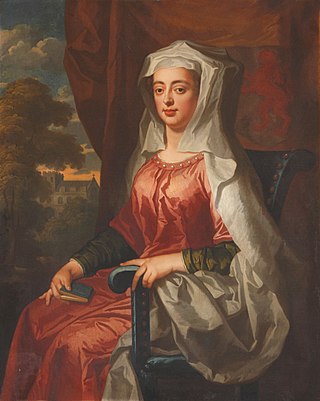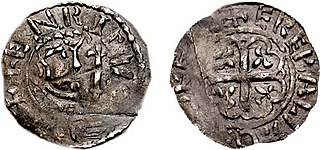Related Research Articles

David I or Dauíd mac Maíl Choluim was a 12th-century ruler who was Prince of the Cumbrians from 1113 to 1124 and later King of Scotland from 1124 to 1153. The youngest son of Malcolm III and Margaret of Wessex, David spent most of his childhood in Scotland, but was exiled to England temporarily in 1093. Perhaps after 1100, he became a dependent at the court of King Henry I of England, by whom he was influenced.

Malcolm IV, nicknamed Virgo, "the Maiden" was King of Scotland from 1153 until his death. He was the eldest son of Henry, Earl of Huntingdon and Northumbria and Ada de Warenne. The original Malcolm Canmore, a name now associated with his great-grandfather Malcolm III, he succeeded his grandfather David I, and shared David's Anglo-Norman tastes.

Roger de Quincy, 2nd Earl of Winchester, hereditary Constable of Scotland, was a nobleman of Anglo-Norman and Scottish descent who was prominent in both England and Scotland, at his death having one of the largest baronial landholdings in the two kingdoms.
David of Scotland was a Scottish prince and Earl of Huntingdon. He was the grandson of David I and the younger brother of two Scottish kings, Malcolm the Maiden and William the Lion.
Helen of Galloway was a daughter and co-heiress of Alan, Lord of Galloway and his first wife, a daughter of Roger de Lacy, Constable of Chester. Helen was the first wife of Roger de Quincy, Earl of Winchester. Although Helen was the first of Roger's three wives, his only descendants were his three daughters by Helen. The eldest daughter, Margaret, married William de Ferrers, Earl of Derby ; the second daughter, Elizabeth, married Alexander Comyn, Earl of Buchan ; the third daughter, Helen, married Alan de la Zouche.
Alan of Galloway was a leading thirteenth-century Scottish magnate. As the hereditary Lord of Galloway and Constable of Scotland, he was one of the most influential men in the Kingdom of Scotland and Irish Sea zone.

Fergus of Galloway was a twelfth-century Lord of Galloway. Although his familial origins are unknown, it is possible that he was of Norse-Gaelic ancestry. Fergus first appears on record in 1136, when he witnessed a charter of David I, King of Scotland. There is considerable evidence indicating that Fergus was married to an illegitimate daughter of Henry I, King of England. It is possible that Elizabeth Fitzroy was the mother of Fergus's three children.
Lochlann of Galloway, also known as Lochlan mac Uchtred and by his French name Roland fitz Uhtred, was the son and successor of Uchtred, Lord of Galloway as the "Lord" or "sub-king" of eastern Galloway.

Donnchadh was a Gall-Gaidhil prince and Scottish magnate in what is now south-western Scotland, whose career stretched from the last quarter of the 12th century until his death in 1250. His father, Gille-Brighde of Galloway, and his uncle, Uhtred of Galloway, were the two rival sons of Fergus, Prince or Lord of Galloway. As a result of Gille-Brighde's conflict with Uhtred and the Scottish monarch William the Lion, Donnchadh became a hostage of King Henry II of England. He probably remained in England for almost a decade before returning north on the death of his father. Although denied succession to all the lands of Galloway, he was granted lordship over Carrick in the north.

Dervorguilla of Galloway was a "lady of substance" in 13th century Scotland, the wife from 1223 of John de Balliol and mother of John I, a future king of Scotland.

Henry of Scotland was heir apparent to the Kingdom of Alba. He was also the 3rd Earl of Northumbria and the 3rd Earl of Huntingdon. He was the son of King David I of Scotland and Queen Maud, 2nd Countess of Huntingdon.
Hugh de Morville of Appleby in Westmorland, England, hereditary Constable of Scotland, was a Norman knight who made his fortune in the service of David FitzMalcolm (d.1153), Prince of the Cumbrians, later King of Scotland.

Before David I became the King of Scotland in 1124, he was the prince of the Cumbrians and earl of a great territory in the middle of England acquired by marriage. This period marks the beginning of his life as a great territorial lord. Circa 1113, the year in which King Henry I of England arranged his marriage to an English heiress and the year in which for the first time David can be found in possession of "Scottish" territory, marks the beginning of his rise to Scottish leadership.

The relationship between the Kingdom of England and King David I, who was King of Scotland between 1124 and 1153, was partly shaped by David's relationship with the particular King of England, and partly by David's own ambition. David had a good relationship with and was an ally of Henry I of England, the King who was largely responsible for David's early career. After Henry's death, David upheld his support for his niece, the former Empress-consort, Matilda, and expanded his power in northern England in the process, despite his defeat at the Battle of the Standard in 1138.
Ada de Warenne was the Anglo-Norman wife of Henry of Scotland, Earl of Northumbria and Earl of Huntingdon. She was the daughter of William de Warenne, 2nd Earl of Surrey by Elizabeth of Vermandois, and a great-granddaughter of Henry I of France. She was the mother of Malcolm IV and William I of Scotland.
Thomas of Galloway, known in Gaelic sources as Tomás Mac Uchtraigh, was a Gall-Gaidhil prince and adventurer. The son of Lochlann, king of Galloway, Thomas was an active agent of his brother Alan of Galloway as well as the English and Scottish kings. When King John, the English monarch, decided that central and western Ulster were to be added to his dominions, he conscripted Thomas and Alan of Galloway to his aid, offering them much of later counties Antrim, Londonderry and Tyrone as incentive.
Walter Byset, Lord of Aboyne was a Scoto-Norman nobleman.
Sir Robert de Quincy, Justiciar of Lothian, was a 12th-century English and Scottish noble.
The Galloway revolt of 1234–1235 was an uprising in Galloway during 1234–1235, led by Tomás mac Ailein and Gille Ruadh. The uprising was in response to the succession of Alan of Galloway, whereby King Alexander II of Scotland ordered Galloway to be divided the amongst Alan's three heiresses under Norman feudal law. This judgement excluded Alan's illegitimate son Tomás, who believed he was the rightful heir under the Gaelic system of tanistry. Alexander II responded by leading an army into Galloway to crush the rebellion. The Scottish army was almost routed, however was saved by the arrival of Fearchar, Earl of Ross and his forces. Walter Comyn, Lord of Badenoch was left to mop up the revolt, however was forced to abandon the region. Patrick II, Earl of Dunbar led another army in 1235, with Adam, Abbot of Melrose, and Gilbert, Bishop of Galloway and forced the submission of Tomás and Gille.
Events from the 1230s in the Kingdom of Scotland.
References
- Oram, RD (2000). The Lordship of Galloway. Edinburgh: John Donald. ISBN 0-85976-541-5.
- Oram, RD (2004). "Alan, lord of Galloway (b. before 1199, d. 1234)" . Oxford Dictionary of National Biography (online ed.). Oxford University Press. doi:10.1093/ref:odnb/49362.(Subscription or UK public library membership required.)
- Prestwich, M (2005). Plantagenet England, 1225–1360. New Oxford History of England. Oxford: Clarendon Press. ISBN 0-19-822844-9.
- Stringer, KJ (1985). Earl David of Huntingdon, 1152–1219: A Study in Anglo-Scottish History. Edinburgh: Edinburgh University Press. ISBN 0-85224-486-X.
- Stringer, KJ (1998) [1993]. "Periphery and Core in Thirteenth-Century Scotland: Alan Son of Roland, Lord of Galloway and Constable of Scotland". In Grant, A; Stringer, KJ (eds.). Medieval Scotland: Crown, Lordship and Community. Edinburgh: Edinburgh University Press. pp. 82–113. ISBN 0-7486-1110-X.
- Stringer, K (2008). "David, earl of Huntingdon and lord of Garioch (1152–1219)" . Oxford Dictionary of National Biography (online ed.). Oxford University Press. doi:10.1093/ref:odnb/49365.(Subscription or UK public library membership required.)